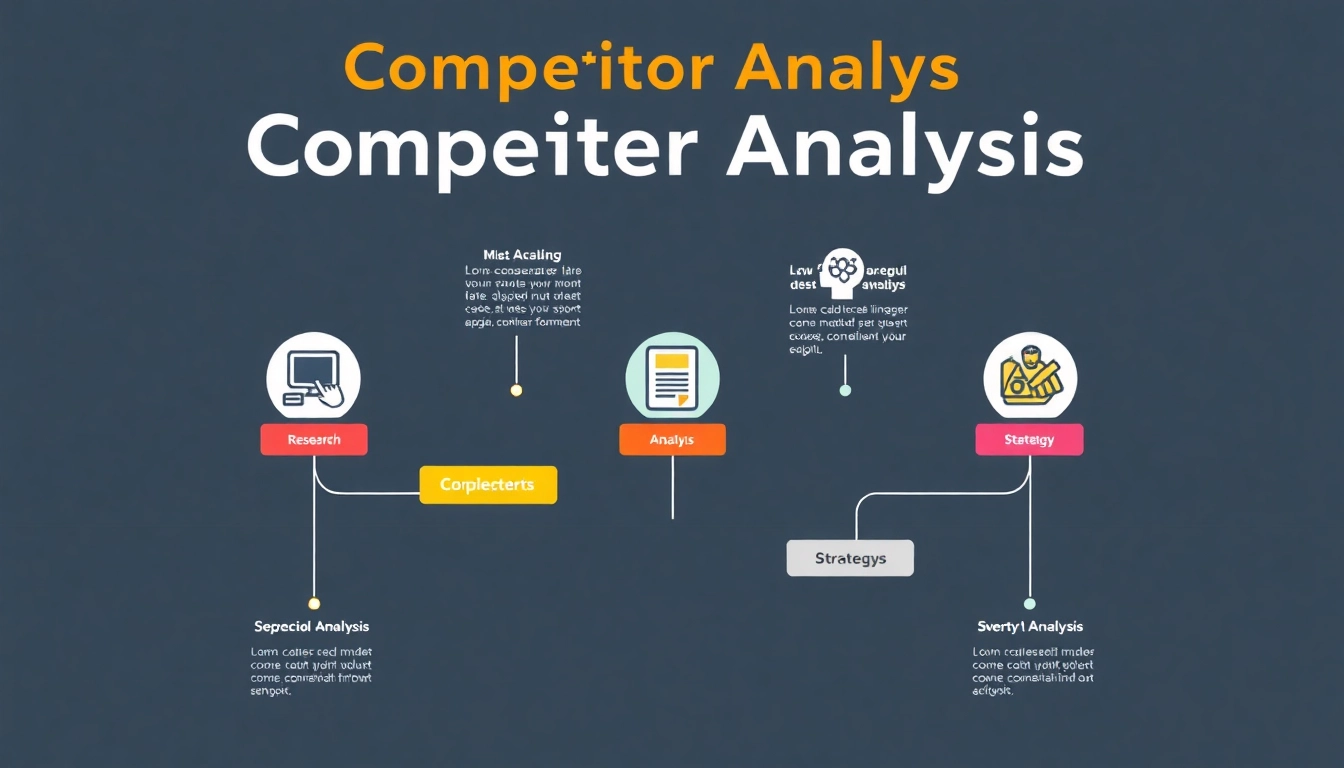Understanding Competitor Analysis
What is Competitor Analysis?
Competitor analysis, often referred to as competitive analysis or competition analysis, constitutes a crucial component of strategic business planning. It involves the systematic examination of similar brands operating in your industry, aiming to garner insights into their offerings, branding, sales methodologies, and marketing approaches. A thorough competitor analysis can provide organizations with a vantage point from which to evaluate their standing relative to the competition, identifying opportunities and threats in the process.
Why is It Important?
The importance of conducting a detailed competitor analysis cannot be overstated in today’s saturated market landscape. Key factors contributing to its significance include:
- Market Positioning: Understanding your competitors helps to shape your brand’s positioning within the market. By comparing your services or products with others, you can identify unique selling points (USPs) that set you apart.
- Strategic Insights: Insights gained from competitor strategies can inform your business decisions, allowing for better planning and execution.
- Identifying Strengths and Weaknesses: It enables you to pinpoint where you excel and where your competitors might have the upper hand, fostering the enhancement of your offerings.
- Market Trends: Studying competitors reveals trends that can impact your business, from pricing strategies to customer satisfaction levels.
- Risk Mitigation: By knowing who your competitors are and what they are doing, you can better anticipate market shifts and be proactive in mitigating business risks.
Key Components of Effective Analysis
Effective competitor analysis encompasses several critical components, including:
- Competitor Identification: Knowing who your competitors are (direct and indirect) helps set the stage for further analysis.
- Market Segmentation: Identifying target market segments that your competitors are actively engaging can highlight gaps in your own strategy.
- Strengths and Weaknesses: Understanding the strengths that give competitors an edge and weaknesses you can capitalize on is vital.
- Target Audience: Analyzing the demographics and psychographics of your competitors’ customers reveals opportunities for targeting your own audience more effectively.
Steps to Conduct a Competitor Analysis
Identifying Your Competitors
Begin by identifying both direct and indirect competitors operating in your industry. Direct competitors are those that offer similar products or services in the same geographical area, while indirect competitors may offer alternatives that serve the same customer need. Tools such as Google Search, industry reports, and customer feedback can be effective in uncovering these competitors.
Collecting Relevant Data
Once competitors are identified, the next step is to compile relevant data. This includes:
- Product Offerings: Evaluate competitors’ products or services, focusing on features, pricing, and customer reviews.
- Marketing Strategies: Analyze how competitors position themselves in the market, what channels they use, and their messaging strategies.
- Sales Techniques: Research the sales tactics and techniques your competitors utilize—this can help inform your approach to lead generation and customer engagement.
- Customer Feedback: Reviewing customer feedback on platforms such as social media or rating sites will help highlight both strengths and weaknesses across the competition.
Analyzing Strengths and Weaknesses
With the data collected, conduct a SWOT analysis (Strengths, Weaknesses, Opportunities, Threats) for each key competitor. This tool simplifies and structures the analysis process, giving a complete picture of where your competitors stand in relation to your brand. It also sheds light on areas you can improve upon or completely distinct opportunities you can explore.
Tools for Competitor Analysis
Top Competitor Analysis Tools
Leveraging the right tools can amplify the effectiveness of your competitor analysis. Here are some highly regarded tools:
- SEMrush: Ideal for analyzing competitors’ SEO and paid advertising strategies.
- Ahrefs: An invaluable tool for examining backlink profiles and keyword rankings.
- Similarweb: Provides web traffic insights, allowing you to benchmark directly against competitors.
- BuzzSumo: Useful for evaluating content performance, helping identify what works well in your industry.
- Sprout Social: Focuses on social media analysis and engagement tracking, invaluable for understanding competitor presence on these platforms.
Using Data Analytics for Insights
In today’s data-driven world, integrating analytics into your competitor analysis process is non-negotiable. Keep track of metrics such as web traffic, conversion rates, and social media engagement. Google Analytics and similar platforms allow you to gain insights into how your competitors attract and retain customers, which can inform your strategic decisions and help optimize your performance.
Integrating Online and Offline Data
Effective competitor analysis requires a blend of online and offline data collection. Online data often includes information gathered from websites, social media, and review channels. Offline data may come from customer surveys, industry events, and market research studies. By combining these sources, you gain a holistic view of the competitive landscape, sharpening your strategic insights.
Leveraging Competitor Analysis for Strategy
Defining Your Unique Value Proposition
Through competitor analysis, you should be able to articulate your unique value proposition (UVP). A clear UVP differentiates your brand from competitors and communicates its distinct advantages to potential customers. Evaluating where your competitors excel highlights what you should emphasize or improve upon to enhance your market appeal.
Adjusting Marketing Tactics Based on Findings
Insights gained from understanding your competitors should guide the adjustment of your marketing tactics. If competitors are heavily leveraging a particular platform or content type, consider incorporating similar strategies while ensuring that you maintain your brand identity. This may involve refining messaging, enhancing product features, or even reconsidering pricing models based on comparative analysis.
Measuring Competitive Advantage
The effectiveness of your competitive strategies should be continuously monitored through key performance indicators (KPIs) tailored to your specific business goals. Metrics such as market share, customer acquisition cost, and customer lifetime value can provide valuable insights into how well you are competing against other market players. This level of measurement not only reveals your current standing but also helps in future strategy formulation.
Case Studies and Real-World Examples
Successful Competitor Analysis: A Case Study
One notable example of successful competitor analysis can be seen in the technology sector, where Company A conducted an exhaustive analysis of its top competitors. By evaluating the competitors’ strengths, weaknesses, market positioning, customer feedback, and marketing tactics, Company A identified untapped market segments where existing offerings were lacking. This led them to develop a unique product tailored to meet these needs, resulting in a significant market share increase within a year.
Common Pitfalls to Avoid
Engaging in competitor analysis is not without its challenges. Common pitfalls include:
- Overlooking Indirect Competitors: Focusing only on direct competitors can lead to a missed opportunity to innovate based on alternative solutions that customers may turn to.
- Neglecting To Update Findings: The competitive landscape is ever-changing; thus, continual analysis is required to remain relevant.
- Biased Analysis: Objective analysis is paramount; personal bias can skew the results and lead to flawed decision-making.
Future Trends in Competitor Analysis
As the market landscape evolves, competitor analysis will likely shift towards incorporating advanced technologies such as artificial intelligence (AI) and machine learning (ML). These technologies can automate the data collection process, provide deep insights, and predict future market trends based on historical data. Furthermore, real-time analysis will become increasingly vital as businesses seek to adapt quickly to changes in consumer preferences and competitive strategies.















Leave a Reply